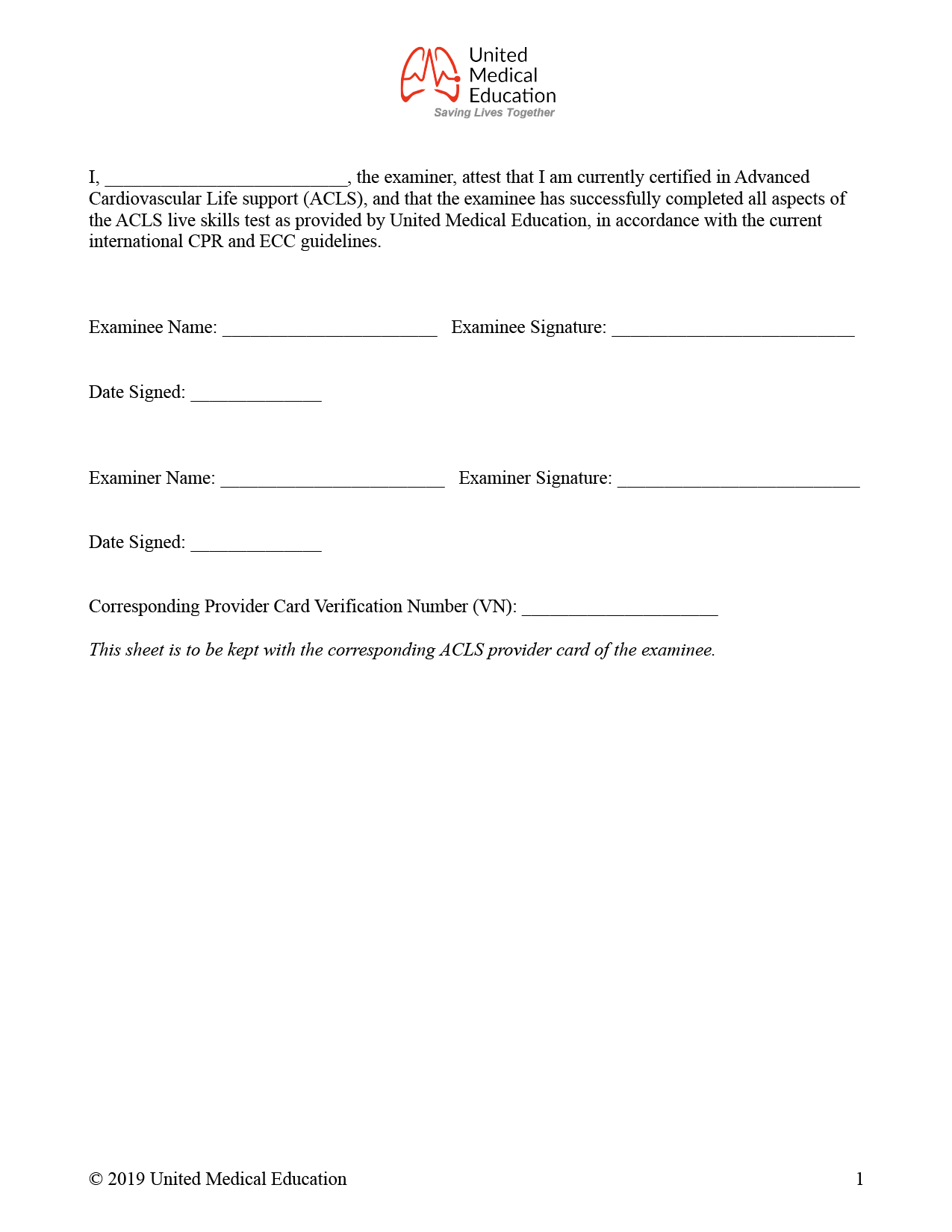What is the ACLS Skills Session?
The Advanced Cardiac Life Support (ACLS) skills session is an optional live examination portion to ACLS certification. During the skills session test an ACLS certified examiner will guide the student through a series of life-threatening cardiopulmonary scenarios commonly referred to as megacodes. During each megacode the student will be required to demonstrates a solid grasp of ACLS concepts and mechanics. Megacodes will generally cover the fundamental mechanics of cardiopulmonary resuscitation (CPR), advanced airway interventions and management, and the diagnosis and treatment of common cardiac arrhythmias.
Skills Test Administrator
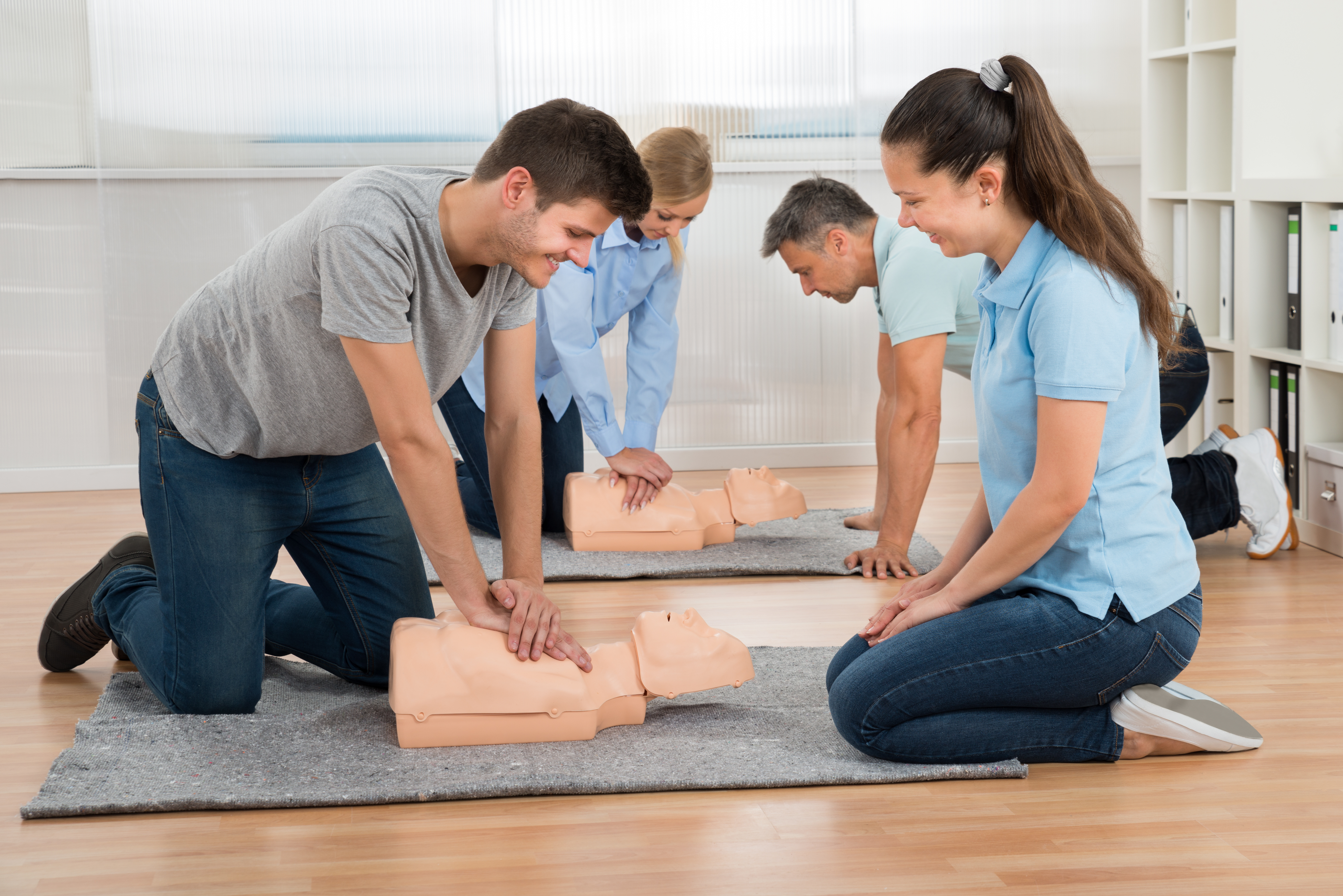
Only a current certified ACLS provider may administer the ACLS skills test. This could include a qualified supervisor, coworker, instructor, or friend.
Institutions also commonly assign an ACLS certified employee to administer our megacodes in group learning. If you’re an institution interested in providing ACLS skills sessions for United Medical Education feel free to use our self-directed instructions and check-off lists.
If you don’t have access to one of the prior convenient options, you may contact an unaffiliated ACLS skills test administrator using the map below.
*Important: You will need to download and print the United Medical Education source “Full ACLS Skills Session PDF Document” below for your skills test examiner.
ACLS Skills Checklist
The ACLS skills checklist is the compilation of both the megacode scenarios and their corresponding checklists used for student evaluation. Directions are provided to both the student, examinee, and skills test administrator, examiner, within the evaluation packet. Once completed the examiner signs the ACLS skills checklist as evidence that the student has passed the optional live skills portion of their certification. For individuals required to have a live skills test with their ACLS certification, the ACLS provider card and the signed ACLS skills checklist are to be kept together once completed.
Below you will find the megacodes and their corresponding checklists. Print these documents and provide them to the skills test administrator.
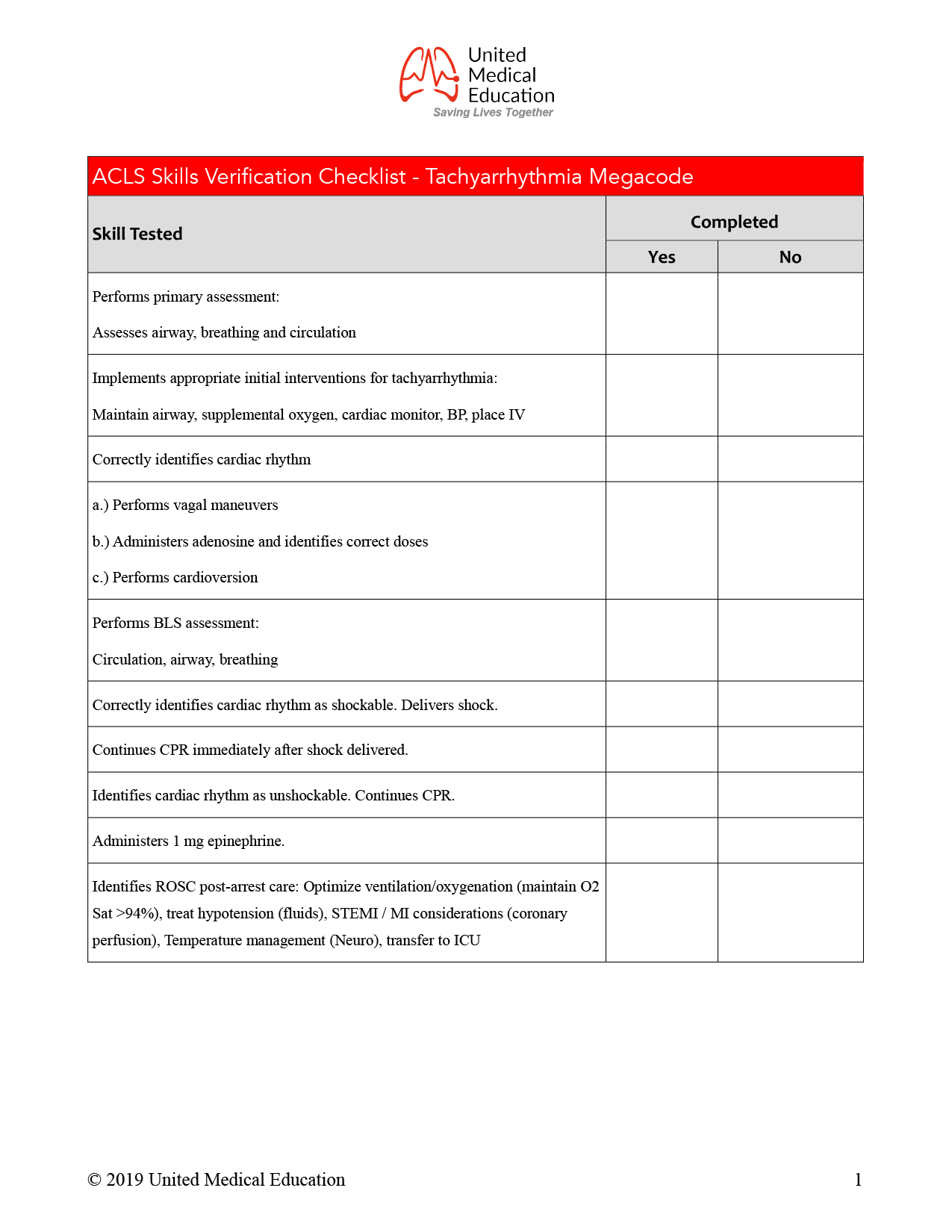
ACLS Skills Checklist Downloads
Here we provide a list of all our ACLS megacodes and checklists necessary for the live skills session. If you’re here to obtain the documents for testing purposes we recommend you download and print the “Full ACLS Skills Session PDF Document” below. We also provide each megacode and checklist in individual sections if you want to use them for personal review.
DIRECTIONS for Skills Testing:
The test administrator, examiner, will read the case scenarios to the student and follow the checklists, marking each step Completed as the student works through each scenario. In order to have a step marked complete the student must demonstrate a solid grasp of BLS/ACLS concepts and mechanics. The test administrator should not provide guidance to the student but may answer questions given the information provided in the scenario. Each scenario should take approximately 10 minutes to complete. In the event the administrator must guide the student through a step, the step must be counted as incomplete and the student should repeat the skills checklist. The student should receive feedback on areas needing improvement before retesting skills.
*DISCLAIMER: Only a current certified ACLS provider can administer the test.
BLS Scenario Checklist
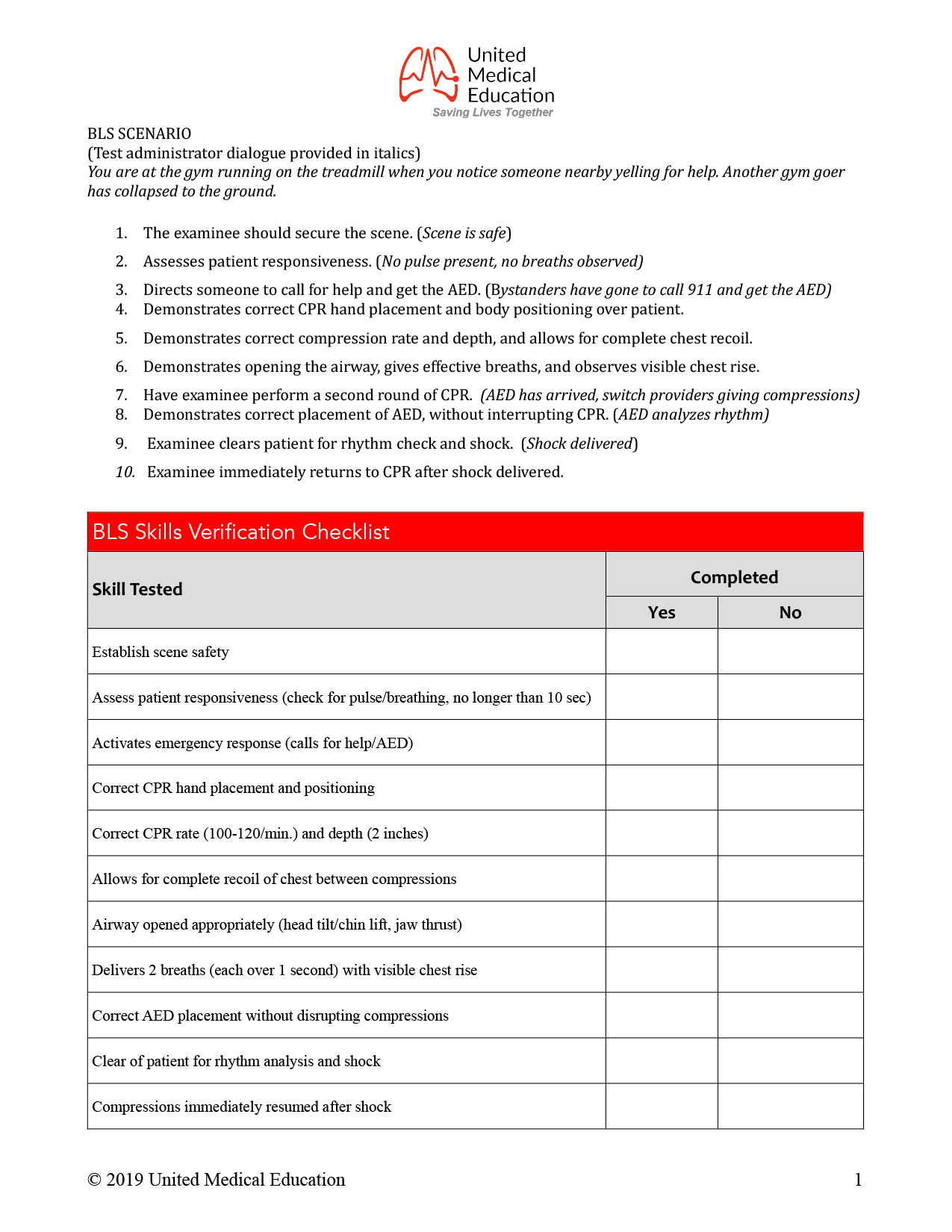
During the ACLS skills session the examinee must also complete an adult BLS skills scenario. Using the button above you can navigate to our page with this full information.
ACLS Airway Checklist
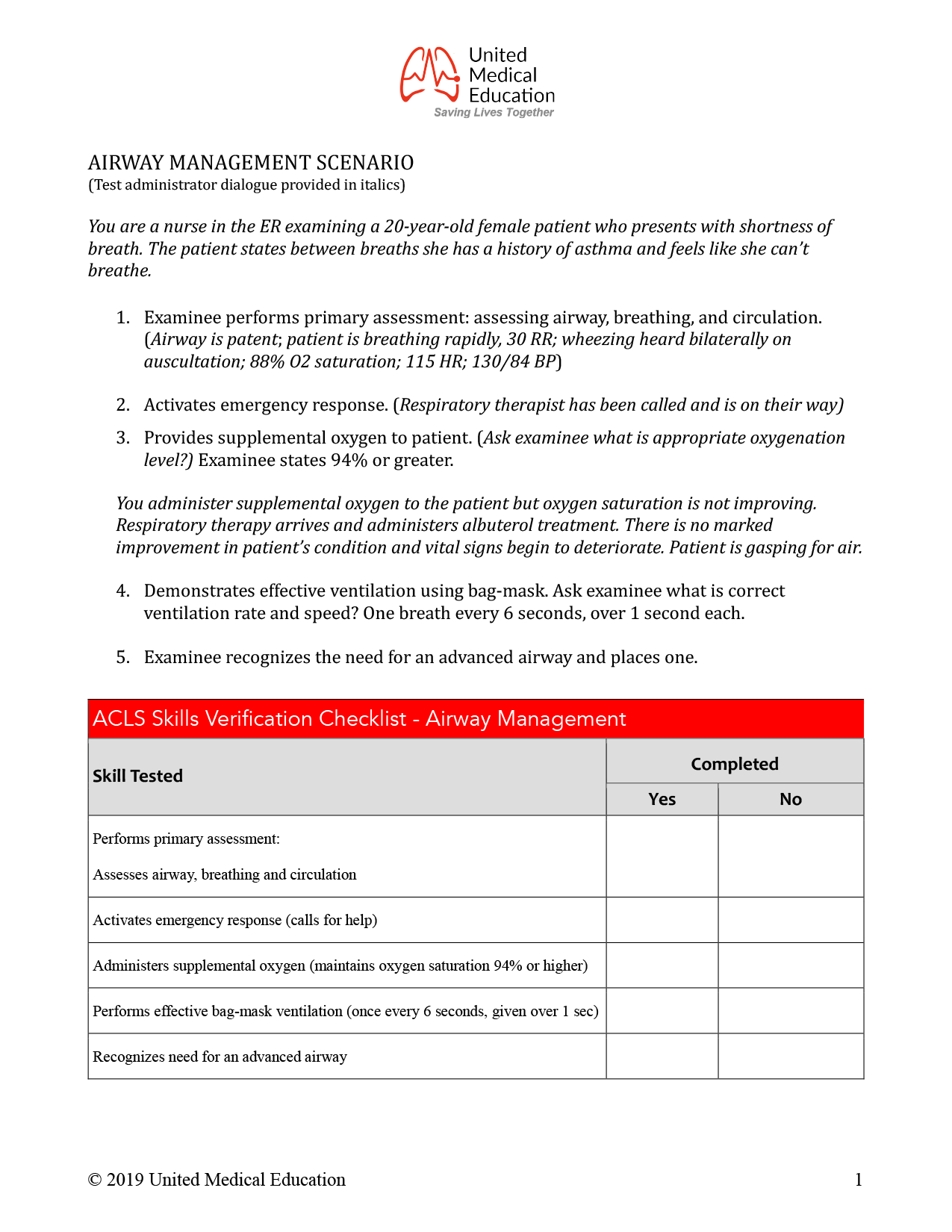
Airway Management Megacode Scenario
(Test administrator dialogue provided in italics)
You are a nurse in the ER examining a 20-year-old female patient who presents with shortness of breath. The patient states between breaths she has a history of asthma and feels like she can’t breathe.
1. Examinee performs primary assessment: assessing airway, breathing, and circulation. (Airway is patent; patient is breathing rapidly, 30 RR; wheezing heard bilaterally on auscultation; 88% O2 saturation; 115 HR; 130/84 BP)
2. Activates emergency response. (Respiratory therapist has been called and is on their way)
3. Provides supplemental oxygen to patient. (Ask examinee what is appropriate oxygenation level?) Examinee states 94% or greater.
You administer supplemental oxygen to the patient but oxygen saturation is not improving. Respiratory therapy arrives and administers albuterol treatment. There is no marked improvement in patient’s condition and vital signs begin to deteriorate. Patient is gasping for air.
4. Demonstrates effective ventilation using bag-mask. Ask examinee what is correct ventilation rate and speed? One breath every 6 seconds, over 1 second each.
5. Examinee recognizes the need for an advanced airway and places one.
| ACLS Skills Verification Checklist – Airway Management | ||
|---|---|---|
| Skill Tested | Completed | |
| Yes | No | |
| Performs primary assessment: Assesses airway, breathing and circulation | ||
| Activates emergency response (calls for help) | ||
| Administers supplemental oxygen (maintains oxygen saturation 94% or higher) | ||
| Performs effective bag-mask ventilation (once every 6 seconds, given over 1 sec) | ||
| Recognizes need for an advanced airway | ||
ACLS Tachyarrhythmia Checklist

Tachyarrhythmia Megacode Scenario
(Test administrator dialogue provided in italics)
You are an ER physician examining a 50-year-old male that presents to the ER complaining of light-headedness and shortness of breath.
1. Examinee assesses airway, breathing, and circulation. (Airway is patent; 24 RR; 154 HR; 90% O2 Sat; 120/84 BP)
2. Examinee initiates appropriate interventions: maintains open airway and oxygenation, places IV, places cardiac monitor, and monitors patient’s BP.
3. Show examinee rhythm strip for SVT. Examinee correctly identifies rhythm.
4. Examinee performs vagal maneuvers. (No change in patient condition.)
5. Examinee administers Adenosine, initial dose 6 mg. (No change after initial dose of Adenosine. Patient remains in SVT.)
6. Examinee administers second dose of Adenosine, dose 12 mg. (Patient’s condition has not improved. Patient remains in SVT)
7. Examinee should move on to cardioversion. Have examinee state dose, 100 J. (After synchronized cardioversion patient goes unconscious.)
8. Examinee assesses for pulse, breathing. (Patient does not have a pulse. The monitor shows the following rhythm) Show examinee rhythm strip for VT; have them identify.
9. Examinee recognizes VT as a shockable rhythm. Defibrillates patient. Commences CPR.
10. At rhythm check (2 min mark) show examinee rhythm strip for PEA; have them identify.
11. Examinee should continue CPR. Administer 1 mg epinephrine. Consider H&T’s. Patient has ROSC.
12. Examinee should identify post-cardiac arrest care measures.
| ACLS Skills Verification Checklist – Tachyarrhythmia Megacode | ||
|---|---|---|
| Skill Tested | Completed | |
| Yes | No | |
| Performs primary assessment: Assesses airway, breathing and circulation | ||
| Implements appropriate initial interventions for tachyarrhythmia: Maintain airway, supplemental oxygen, cardiac monitor, BP, place IV | ||
| Correctly identifies cardiac rhythm | ||
| a.) Performs vagal maneuvers b.) Administers adenosine and identifies correct doses c.) Performs cardioversion | ||
| Performs BLS assessment: Circulation, airway, breathing | ||
| Correctly identifies cardiac rhythm as shockable. Delivers shock. | ||
| Continues CPR immediately after shock delivered. | ||
| Identifies cardiac rhythm as unshockable. Continues CPR. | ||
| Administers 1 mg epinephrine. | ||
| Identifies ROSC post-arrest care: Optimize ventilation/oxygenation (maintain O2 Sat >94%), treat hypotension (fluids), STEMI / MI considerations (coronary perfusion), Temperature management (Neuro), transfer to ICU | ||
ACLS Bradyarrhythmia Checklist

Bradyarrhythmia Megacode Scenario
(Test administrator dialogue provided in italics)
67 year-old male presents to the ER for altered mental status. Patient reports feeling tired and his wife states he has had some confusion.
1. Examinee assesses airway, breathing, and circulation. (No airway compromise; 18 RR breath sounds clear; 42 HR; 90% O2 Sat; 80/56 BP)
2. Examinee initiates appropriate interventions: maintain airway and oxygenation, places IV, places cardiac monitor, monitors patient’s BP and ECG.
3. Show examinee rhythm strip for sinus bradycardia; have them identify.
4. Examinee recognizes need to administer atropine, initial dose 0.5 mg bolus. (Three minutes later you administer a second dose as well with no change in patient condition.)
5. Examinee should move on to transcutaneous pacing. (The patient suddenly goes unconscious.)
6. Examinee assesses for pulse and breathing. (Patient does not have a pulse. The monitor shows the following rhythm) Show examinee rhythm strip for VT; have them identify.
7. Examinee recognizes VT as shockable rhythm. Defibrillates patient. Commences CPR.
8. At rhythm check (2 min mark) show examinee rhythm strip for PEA; have them identify.
9. Examinee should continue CPR. Administer 1 mg epinephrine. Consider H&T’s.
(Patient has ROSC.)
10. Examinee should identify post-cardiac arrest care measures.
| ACLS Skills Verification Checklist – Bradyarrhythmia Megacode | ||
|---|---|---|
| Skill Tested | Completed | |
| Yes | No | |
| Performs primary assessment: Assesses airway, breathing and circulation | ||
| Implements appropriate initial interventions for tachyarrhythmia: Maintain airway, supplemental oxygen, cardiac monitor, BP, place IV | ||
| Correctly identifies cardiac rhythm | ||
| Administers correct dose of atropine 0.5 mg. | ||
| Performs transcutaneous pacing. | ||
| Performs BLS assessment: Circulation, airway, breathing | ||
| Correctly Identifies cardiac rhythm as shockable. Delivers shock. | ||
| Continues CPR immediately after shock delivery. | ||
| Identifies cardiac rhythm as unshockable. Continues CPR. | ||
| Administers 1 mg epinephrine. | ||
| Identifies ROSC post-arrest care: Optimize ventilation/oxygenation (maintain O2 Sat >94%), treat hypotension (fluids), STEMI/ MI considerations (coronary perfusion), Temperature management (Neuro), transfer to ICU | ||
Megacode Rhythm Strips
1.

2.

3.

4.

MEGACODE RHYTHM STRIPS KEY:
1. Supraventricular Tachycardia (SVT)
2. Ventricular Tachycardia – Monomorphic (VT)
3. Pulseless Electrical Activity (PEA)
4. Sinus Bradycardia
ACLS Skills Session
Certificate Form
